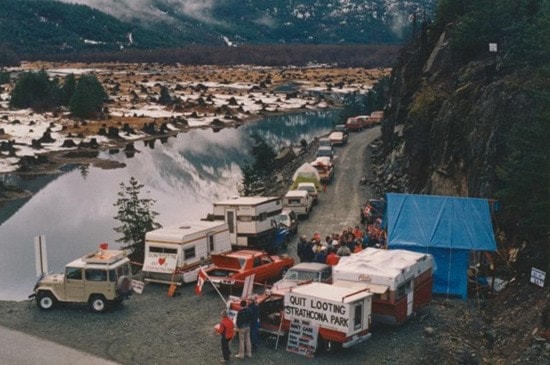Changes to B.C.'s Park Act remind Marlene Smith of the months spent defending Strathcona Provincial Park from exploratory mine drilling during the Strathcona Blockade of 1988.
Smith is a founding member of Friends of Strathcona Park, (FOSP), which was developed in response to changes the government-of-the-day made — paving the way for industrial activity to occur in the park — about a year before the blockade started.
According to the FOSP website, government created an industrial corridor through the centre of Strathcona Park, and adjusted boundaries to remove certain areas from the park. The public expressed concern via letters, telephone calls and meetings, but when Cream Silver Mines started moving drilling equipment into the Cream Lake area of the park, the blockade began.
The 63-year-old Smith clearly remembers the three-month blockade, which was in the midst of winter and included 64 arrests — and which pressured government to develop safeguards to ensure the park was protected.
"Strathcona Park was safe for 25 years but now it is no longer," says Smith. "The protection that we had before Monday (Feb. 24) that would safeguard Strathcona Park, and our other provincial parks, from industrial development within the boundaries of the park, that safeguard has dropped.
"It is now wide open again to potential mining, logging, run-of-the-river projects, road building, you name it."
Bill 4, the Park Amendment Act, was passed last week. It allows 'research' to include feasibility studies for a range of industrial activities, such as pipelines, transmission lines, roads or highways, or "a prescribed project or a project in a prescribed class of projects."
The bill also allows the minister to grant a park use permit if the research is “necessary to inform decision making around changing the boundaries,” according to a news release from FOSP.
Smith continues: "The primary concern is parks on the Lower Mainland and on the mainland that might be dissected and be destroyed, or parts of them destroyed, to allow pipeline building, road-building, logging roads or other roads, and the long-term concern is that it would open areas like Strathcona Park again for future claim staking and mine development."
Comox Valley Naturalists Society president Loys Maingon, who is also B.C. director of Canadian Society of Environmental Biologists, also points to oil and gas infrastructure in the Interior and Lower Mainland area as a driver behind the changes to the Park Act.
"If one believes that the future is in the development of oil and gas, high transmission lines, there's no doubt that given the distribution of parks throughout B.C. it is extremely difficult to build the infrastructure for that without encountering a park," he says, adding there are now about 1,300 parks in the province, up from 205 in the early 1970s.
"Where it becomes highly problematic is that the parks are really our protected areas, they're our green spaces; we have every other place in B.C. accessible for development."
Maingon notes that while parkland has increased, park staff has decreased, down to about 100 in the province, which means the parks system has little or no staff to do feasibility studies.
"This (work) will be contracted out to agents of industry, which will be self-regulated and self-assessed," he continues. "It is disturbing and unnerving to consider what is really implied by this research. There's a failure to protect and to regulate and, as usual, in this bill everything is left at the discretion of the ministry.
"This is really political interference without adequate scientific guidance. There has to be a more stringent approach to the parks, independent of government."
Meanwhile, Smith says organizations, such as the Wilderness Society, Canadian Parks and Wilderness and Federation of Mountain Clubs of BC have joined to fight the changes to the Park Act. West Coast Environmental Law is looking into the legality of the changes, according to Smith.
For more information, visit http://friendsofstrathcona.org or the websites of any of the groups listed.
writer@comoxvalleyrecord.com
